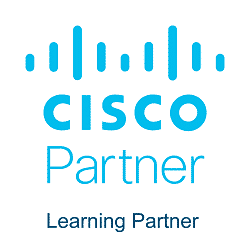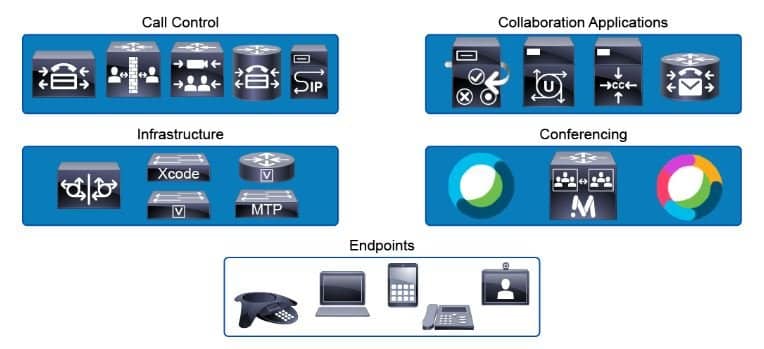Obiettivi | Certificazione | Contenuti | Tipologia | Prerequisiti | Durata e Frequenza | Docenti | Modalità di Iscrizione | Calendario

Il Corso CLFNDU Understanding Cisco Collaboration Foundations fornisce al partecipante le competenze e le conoscenze necessarie per amministrare e supportare una soluzione Cisco® Unified Communications Manager (CM) a sito singolo con gateway SIP (Session Initiation Protocol). Il corso copre le impostazioni iniziali fondamentali, la gestione dei dispositivi inclusi telefoni e endpoint video, la gestione degli utenti e la gestione delle risorse multimediali, nonché gli strumenti di manutenzione e risoluzione dei problemi delle soluzioni Cisco Unified Communications. Inoltre, si affronteranno le basi dei dial plan SIP tra cui la connettività ai servizi PSTN (Public Switched Telephone Network) e come utilizzare le funzionalità di class-of-service.
Contattaci ora per ricevere tutti i dettagli e per richiedere, senza alcun impegno, di parlare direttamente con uno dei nostri Docenti (Clicca qui)
oppure chiamaci subito al nostro Numero Verde (800-177596)
Obiettivi del corso
Di seguito una sintesi degli obiettivi principali del Corso CLFNDU Understanding Cisco Collaboration Foundations:
- Acquisizione delle competenze per amministrare e supportare Cisco® Unified Communications Manager.
- Gestione di dispositivi come telefoni ed endpoint video.
- Apprendimento sulla gestione degli utenti e delle risorse multimediali.
- Uso di strumenti per la manutenzione e risoluzione dei problemi.
- Comprensione delle basi dei dial plan SIP e connettività ai servizi PSTN.
Certificazione del corso
Questo corso tratta contenuti trasversali a diverse Certificazioni Cisco Collaboration
Contenuti del corso
- Exploring the Path to Collaboration
- Define Collaboration
- Migrate Networks to Support Collaboration
- Understand the Collaboration Endpoints
- Understand the Collaboration Call Controllers
- Describe On-Premises, Cloud, and Hybrid Deployments
- Administering Initial Parameters for Cisco Unified Communications Manager
- Understand the On-Premise Collaboration Deployment Models
- Describe the Cisco Unified CM Cluster Services
- Define Network Services for Collaboration
- Configure Cisco Unified Communications Manager Initial Parameters
- Explore Cisco Unified CM Groups
- Configure the Cisco UCM Core System Settings
- Exploring Endpoints and the Registration Process
- Identify Cisco Endpoint Solutions
- Explore the Boot up Process of an Endpoint
- Describe Power Over Ethernet
- Configure an Access Switch for an Endpoint
- Describe IP Network Settings
- Deploy an IP Phone Through Auto and Manual Registration
- Practice Activity
- Exploring Codecs and Call Signaling
- Describe the Call Setup and Teardown Process
- Describe SIP Call Signaling for Call Setup and Teardown
- Explore Media Streams at the Application Layer
- Define Codecs
- Compare Audio Codecs
- Compare Video Codecs
- Managing Users in Cisco Unified Communication Manager
- Analyze Cisco UCM User Types and Settings
- Describe Methods for Authenticating Cisco UCM Users
- Create a Local User Account and Configure LDAP
- Practice Activity
- Describing a Basic Dial Plan
- Describe the Concepts of a Dial Plan and Call Routing
- Describe Elements of Call Routing
- Explore Digit Manipulation and Translation Patterns
- Create a Basic Dial Plan
- Explore a Basic Dial Plan
- Describing Class of Service
- Explore the Concepts of Class of Control
- Explore Partitions and Call Search Spaces
- Practice Activity
- Enabling Endpoints and Features
- Configure a Cisco Jabber Endpoint in Cisco UCM
- Deploy an On-Premises Cisco Jabber Client for Windows
- Implement Common Endpoint Features
- Explore Mobility
- Practice Activity
- Describing the Cisco ISR as a Voice Gateway
- Describe Cisco Voice Gateways
- Overview of SIP Gateways
- Describe Call Legs and Dial Peers
- Configure VoIP Dial Peers
- Configure ISDN Circuits and POTS Dial Peers
- Describe Digital Signaling Processors
- Explore the DSP Calculator
- Exploring Cisco Unified Communication Manager Media Resources
- Describe Cisco UCM Media Resources
- Describe Conference Bridges
- Explore Types of Conferences
- Describe Transcoders and Media Termination Points
- Describe Music on Hold
- Control Access to Media Resources
- Reporting and Maintenance
- Explore the Troubleshooting Process
- Describe Reporting and Maintenance Tools
- Describe Cisco Real-Time Monitoring Tool
- Use Reporting and Maintenance Tools
- Exploring Additional Requirements for Video Endpoints
- Describe Room Recommendations for Room and Immersive Endpoints
- Explore Video Endpoint Features
- Explore Endpoint Troubleshooting Tools
- Describing Cisco Unity Connection
- Describe Cisco Voice Messaging Components
- Explore Cisco Unity Connection Architecture and Features
- Examine the Integration between Unity Connection and CUCM
- Explore the Default System Call Handlers
- Examine End User Templates
- Manage Unity Connection Users
Attività Laboratoriali
- Configure Default Cisco Unified CM System and Enterprise Parameters
- Configure the Cisco Unified CM Core System Settings
- Configure an Access Switch for an Endpoint
- Deploy an IP Phone Through Auto and Manual Registration
- Administer Endpoints in Cisco Unified Communications Manager
- Create a Local User Account and Configure LDAP
- Implement Users
- Create a Basic Dial Plan
- Explore Partitions and Call Search Spaces
- Describe Private Line Automatic Ringdown (PLAR)
- Deploy an On-Premise Cisco Jabber® Client for Windows
- Implement Common Endpoint Features
- Configure Common Endpoint Features
- Configure Voice over Internet Protocol (VoIP) Dial Peers
- Configure Integrated Service Digital Network (ISDN) Circuits and Plain Old Telephone Service (POTS) Dial Peers
- Control Access to Media Resources
- Use Reporting and Maintenance Tools
- Explore Endpoint Troubleshooting Tools
- Examine the Integration between Unity Connection and Cisco Unified CM
- Manage Unity Connection Users
Tipologia
Corso di Formazione con Docente
Docenti
I docenti sono Istruttori accreditati CISCO e certificati in altre tecnologie IT, con anni di esperienza pratica nel settore e nella Formazione.
Infrastruttura laboratoriale
Per tutte le tipologie di erogazione, il Corsista può accedere alle attrezzature e ai sistemi reali Cisco presenti nei Nostri laboratori o direttamente presso i data center Cisco in modalità remota h24. Ogni partecipante dispone di un accesso per implementare le varie configurazioni avendo così un riscontro pratico e immediato della teoria affrontata. Ecco di seguito alcune topologie di rete dei Laboratori Cisco Disponibili:

Dettagli del corso
Prerequisiti
Si consiglia la partecipazione al Corso Cisco CCNA.
Durata del corso
- Durata Intensiva 5gg;
Frequenza
Varie tipologie di Frequenza Estensiva ed Intensiva.
Date del corso
- Corso Cisco CLFNDU (Formula Intensiva) – Su richiesta – 9:00 – 17:00
Modalità di iscrizione
Le iscrizioni sono a numero chiuso per garantire ai tutti i partecipanti un servizio eccellente.
L’iscrizione avviene richiedendo di essere contattati dal seguente Link, o contattando la sede al numero verde 800-177596 o inviando una richiesta all’email contatti@vegatraining.eu.


